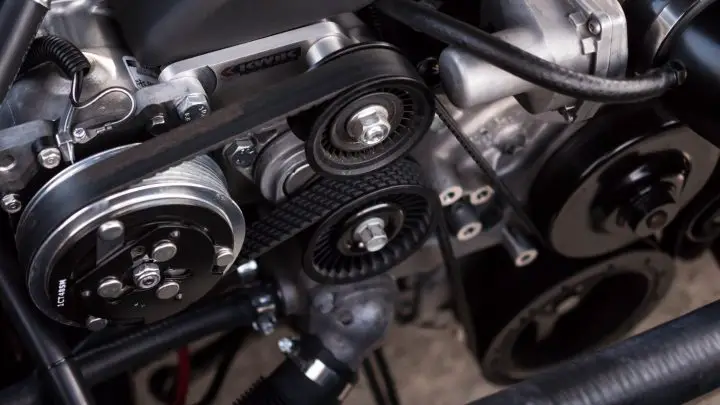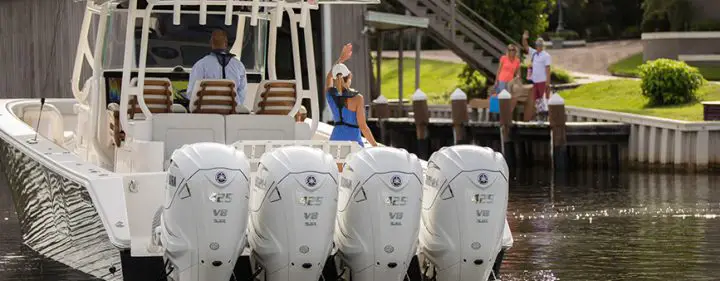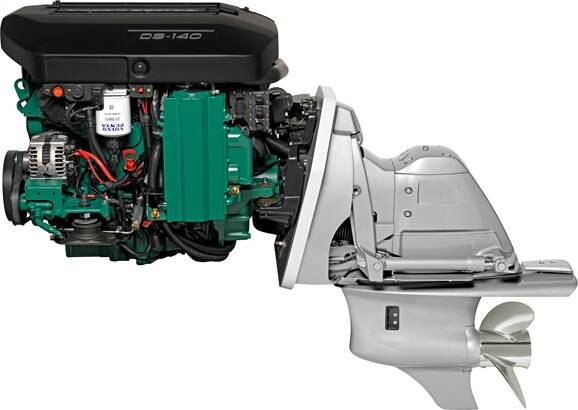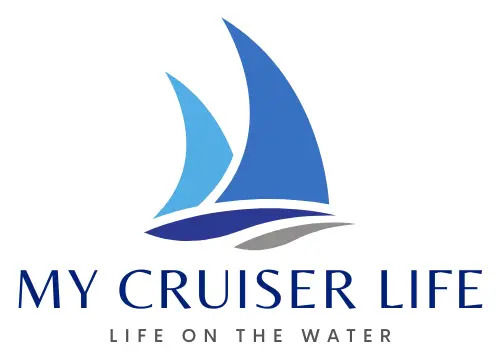Inboard-outboard, inboard, and outboard motors. All terms describe different types of engine setups on boats. Which is best, and how do you decide?
Here’s a primer on all things boat engine related so that you can tell the difference. From a gearhead perspective, it’s all pretty interesting stuff. But from the perspective of a boater who just wants to enjoy a day on the water, it’s a little like comparing which model of SUV you want to rent for vacation. They’ll all do much the same things in the end. What matters most when it comes to boat engines is the type of boat it’s mounted to!
Table of Contents
- Boat Motors Explained
- What Is an Outboard Boat?
- What Are Inboard Boat Motors?
- Outboard vs Inboard Motors – Which Is Better?
- What Is an Inboard/Outboard or IO Motor?
- So, Which is Best?
- FAQs (Frequently Asked Questions)

Boat Motors Explained
Small boats can be categorized by how their engines are mounted. As you might imagine, the engine location impacts a lot of a boat’s performance characteristics, how it handles, and what it looks like.
Types of Boat Inboard vs Outboard
The first two types of boats you should be familiar with are outboard and inboard boats. The word “board” here is used as “you are onboard the boat” or inside it. So an outboard motor is mounted outside the boat, and an inboard motor is located inside the boat.
What about sailboats? Do sailboats have motors? Sailboats usually have low-powered auxiliary motors. On boats less than 25 feet, it’s usually an outboard. Bigger sailing vessels have inboards.
What Is an Outboard Boat?
Outboard motors are the most common type of motor on small vessels these days. They are built from the ground up to be mounted on the back of a boat, from their special mounting brackets, integrated steering controls, and water-resistant exterior cases.
An outboard motor isn’t different from other motors you might be familiar with, be it a small gasoline two-stroke from your lawn mower or six-cylinder, four-stroke car engines like in your Honda Accord. The engine is mounted vertically on a drive shaft, which connects to a lower gearbox under water. The propeller is connected to the gearbox.
Outboards have traditionally ranged in size from 2 to 250 horsepower, but manufacturers are squeezing more and more horsepower out of these motors. Today, the most powerful outboards make more than 600 horsepower. Moreover, boat makers are designing go-fast boats that can mount four or more of these engines!
Outboard engines are mounted on a bracket that attaches to the boat’s transom (you can learn more about it here: What Is the Transom on a Boat). The boat must be designed from the ground up to accept an outboard. Most of them nowadays have brackets that extend behind the transom low to the water where the outboard is mounted.
The outboard pivots on its bracket to steer the boat. So on this type of boat, the helm controls where the propeller thrust is pointed. This is called vectored thrust, meaning that you can’t turn the boat if the propellers aren’t turning. This is an important concept to get a feel for, especially when docking in close quarters.
The outboard also tilts on the bracket so that the thrust from the propeller can help trim the boat. When the boat is on plane, the skipper can pitch the bow up and down to adjust for the boat’s loading and sea conditions. This is an important tool if your boat won’t plane. The tilt and trim unit also allows the entire motor to be tilted up for storage, so when the boat is stopped, the propeller and lower unit will not be sitting in the water.
The biggest outboard engine manufacturers in the world include Yamaha, Suzuki, Honda, Tohatsu, and Mercury. The most common engine found on an outboard is a conventional four-stroke gasoline engine, although electric motor outboards like the Torqeedo and propulsion are catching on.

What Are Inboard Boat Motors?
When outboard motors topped out at 250 horsepower and only two could be mounted on the biggest boats (usually about 27 feet long), there was a case to be made that anything requiring more power would have to be built differently. However, as outboards have advanced in recent years, anything else will have to justify itself in other ways.
An inboard motor is the traditional “other way.” An inboard boat has the engine mounted in the center of the vessel. It lays flat, and a driveshaft extends through the bottom of the hull and connects to a propeller. The entire assembly is securely mounted to load-bearing parts of the boat’s structure, so it’s very robust.
Since the motor doesn’t move, as is the case with an outboard, the boat must be turned using another means. On an inboard boat, the helm wheel turns a rudder. The rudder will be located behind the propeller, so it is very effective if the boat is in forward gear.
The inboard engine is the basic design of any vessel that can’t be fitted with an outboard. Maybe you want a type of motor that isn’t made as an outboard, like diesel or an electric. Sidenote: As of 2022, both of these types of outboards are in production and available but still very rare. They will become more common as the technology is more widely adopted.
Inboards are also used when the boat is simply too big to be pushed by outboard power. Big outboards are heavy and expensive. Chances are you can find a larger inboard boat for less money than one with multiple modern high-power outboards.
Inboard motors come in any shape and style that boat makers can dream up. Small boats have four-cycle gasoline inboards, but above about 30 feet, diesel engines are more common. Diesel motors have longer service lives, are more efficient, and are safer on vessels where gasoline vapors can cause an explosion hazard.
The biggest names in inboard manufacturing for small boats include Yanmar (diesel), Volvo (gas and diesel), and Mercruiser (gas).

Outboard vs Inboard Motors – Which Is Better?
Ok, that describes what these motors are and a little about how they work. Which one is better? Here are the advantages of each type. Of course, there’s no right or wrong answer here. Each has pros and cons, and each is better suited to a particular mission.
It is important to note that the underlying technology of each motor is remarkably similar. If you compare a four-cycle gasoline outboard to a similar inboard, there is not much difference in terms of reliability, fuel burn, maintenance requirements, or life expectancy. If you compare a gasoline motor to diesel, then these things get much more interesting.
Advantages of an Outboard vs Inboard Boat
There is a lot to love about outboard motors. While outboards have been around in recreational boating for over a century now, their technology keeps getting better and better. Fuel economy, maintenance, and replacement costs, and engine weight all keep improving.
- Cheap and easy installation or repowering
- Come with everything–engine, mount, gearbox, propeller, steering hookup, and even helm instruments
- Reduced explosion risk since fuel lines and ignition are kept outside of the boat
- Easy for boat makers to offer different power packages
- Maintenance is easier–and therefore cheaper
- Can be lifted, so all running gear is stored out of the water
- Likewise, you can lift the motors to reduce the boat’s draft and float free of sandbars you inadvertently found
- The trim function can fine-tune the handling of the boat for rough conditions or loading issues
- Motors are outside of the boat hull for less noise and vibration
- Motors do not take up space that would otherwise be used for people, cargo, or fuel
- Clean and quiet four-stroke outboards mean that they are just as efficient and reliable as inboard motors
- Small outboards (two to five horsepower) are easily portable and can be mounted to rowboats, small sailboats, canoes, and Jon boats
- Modern boats with multiple outboards have computerized control systems for joystick docking
Disadvantages of Outboard Motors
- Expensive when compared to similar inboard options (even though installation is usually easier)
- The gearbox is underwater on the lower units and prone to damage
- Mounting all of the weight on the transom of the boat might lead to balance issues
- Raw water cooled can lead to internal corrosion issues if not flushed regularly
Advantages of an Inboard Boat
Despite all of that, inboards still have their place. If a boat is larger than about 40 feet, chances are it will need more power than the current outboards can provide. You can only mount so many to the back of a vessel before its weight balance is completely out of whack.
- It can come in any amount of power, from ten to the 260,000 horsepower turbines used in Nimitz-class aircraft carriers
- Fundamentally simpler in their design and operation, meaning many inboards are made from a converted tractor or car engine
- Robustly and structurally mounted to the boat
- The weight of the engine is kept closer to the center of the boat for better balance and a lower center of gravity
- A traditional method for mounting diesel engines, a safer alternative to gasoline
- Heat exchanger cooling systems limit raw water contact with engine parts
- True inboard engine designs keep the propeller inboard and under the boat, which is safer for skiers and swimmers near the transom
- It keeps the transom clear for a swim platform or for aesthetics
- Only the propeller is outside and in the water
- Since the engine and gearbox are inside the boat, groundings are less likely to cause damage (and some inboard boats have the propeller and inboard shaft well protected by the keel)
Disadvantages of Inboards
- Must be carefully mated to transmission and propeller
- Much more expensive to work on since you must do work inside the boat
- Difficult to replace for a repower–engine must be hoisted in and out carefully with a crane
Here’s a great comparison video looking at two beautiful cruising boats from Back Cove. This is a real-world comparison, looking at what a boat shopper might think about when weighing their outboard vs inboard choice. Note the differences in efficiency discussed are primarily due to the inboard being a diesel model, not because it’s inboard or outboard.
What Is an Inboard/Outboard or IO Motor?
An I/O, or inboard-outboard motor, is a hybrid creation. It’s also sometimes called a sterndrive. It has a traditional inboard motor mounted to a special underwater drive unit. The drive, called the lower unit, turns and trims like an outboard motor. I/Os can be either gasoline or diesel driven.
Traditionally, I/O motors filled the market segment for boats too big for outboard motors. Since the motor is internally mounted in the vessel, larger V8s or V12s could be used.
The basic idea of the I/O is that you get the benefits of both types of engines–you get the weight distribution and power potential of a large inboard with the ease of control offered by an outboard. Further, it declutters the boat for aesthetics and gives you the option of a wide, clean swim platform on the back of the boat.
Only three companies make IOs, Mercruiser, Volvo, and Yanmar. They are only common on one type of boat, the Sea Ray-type power cruiser or express cruiser between 20 and 35 feet long. Anything larger will have bigger inboards, and fishing boats have always preferred outboards or inboards. Ski boats are traditionally made with inboards since they have propellers under the boat and away from swimmers.
One modern take on the I/O is the jetboat. A jetboat uses an inboard motor to drive an impeller pump. The impeller is mounted below the boat and ducted out of a nozzle on the back. The nozzle functions much like an I/O lower unit in that you can turn it to vector the trust. Personal Watercraft–PWCs or jetskis–are a type of jet boat.

Advantages of Outboard vs Inboard Outboard Boats
While I/O boats retain some of the advantages of outboards and inboards, they aren’t all good. I/Os are complex, and the drive unit is prone to failure.
The biggest problem with an I/O is that you cannot lift the drive unit out of the water. This is a maintenance-saving plus to outboards. Since the lower unit is aluminum, it cannot survive for long in saltwater without regular maintenance and protection. So most owners of I/O boats opt to store their boats out of the water–on a lift or in a dry-rack storage facility. Replacement lower units are very expensive.
It’s also true that many of the cost-saving features of an outboard are lost with an I/O. Outboards are easy to maintain and replace because they’re outside the boat–they come off with a few bolts. An I/O has all the costly service issues of inboard and is just as hard to replace. The safety aspects are also lost since gas fumes can still be trapped in the engine compartment with an I/O.
There are limited styles of boats that come with I/Os, to begin with. And many of these manufacturers have begun offering outboard versions in addition to their classic sterndrive-powered hulls. That shift is telling–there probably aren’t many advantages of the old-school I/O when compared to a modern outboard.
Inboard Outboard vs Inboard Boats
So why would you choose an inboard over an I/O? First, inboards are available in a wider variety. As mentioned earlier, only three companies make sterndrives, which must be paired with their respective engine.
So, Which is Best?
As you can see, each boat has its quirks. Answering which is best is one of those dockside topics sure to get people talking. But when you sort through the tradition, personal opinion, and aesthetics, there are few clear-cut winners.
If you’re out boat shopping, there are so many more important questions you need to answer than inboard vs outboard or inboard outboard vs outboard. These are small factors in the overall functionality of a boat. Instead, you should ask how well the boat will suit its purpose and if it is right for me?
FAQs (Frequently Asked Questions)
What are the advantages of an inboard outboard motor?
An inboard-outboard I/O or sterndrive has the controllable lower unit of an outboard, combined with the interior mounted engine. There once was a time when I/Os were considered more reliable and more powerful than outboards, but today the technologies are more or less equal. These days, I/O’s primary advantages are their aesthetics–they leave the boat’s transom clean and provide space for a larger swim platform.
Are inboards safer than outboards?
The answer depends greatly on the type of boat and the type of engine you are talking about. If you compare gasoline inboards to gasoline outboards, there is a clear safety advantage to the outboard. Gasoline fumes easily settle and can ignite in the engine compartment of an inboard vessel. Another safety consideration is the propeller’s location. For example, inboard boats are considered safer for wakeboards or skiers. The propeller is under the boat’s hull and, therefore, always farther away from a swimmer in the water.
Which is faster inboard or outboard?
The speed of a boat comes down more to its hull design, weight, total power, and propeller pitch–so it’s impossible to say which is faster. The fastest boats in the world have inboard motors, but these are racing boats built for that purpose and not the sort of boats you’d go out and purchase.
Which is more fuel efficient inboard or outboard?
The fuel efficiency of an engine depends more on the power loading and efficiency of the overall boat. The most fuel-efficient engines are diesel. Diesel boats have traditionally been limited to inboard designs, although several manufacturers now sell diesel outboards.
Is inboard better than outboard?
It depends on what you want to do with the boat. In truth, neither engine is better than the other–they each have merits and problems. But costs to produce, purchase, maintain, and replace an inboard motor are higher than an outboard, so most small boats come with outboards these days.
Which is quieter inboard or outboard motor?
Modern four-stroke outboard motors are the quietest option. They are mounted aft of the boat’s hull and run nearly silent with no vibration.
